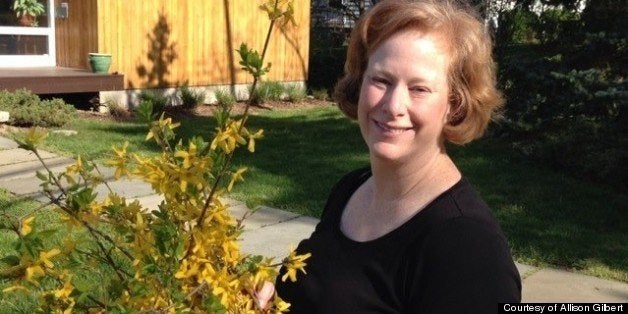
Allison Gilbert is feeling a lot like Angelina Jolie today.
Reading the film star’s Op-Ed piece in the New York Times this morning, about the decision to undergo a prophylactic double mastectomy in the face of a family history of cancer, Gilbert nodded in recognition. Like Jolie, Gilbert’s mother died in her mid-50s. Like Jolie, Gilbert tested positive for the genetic mutation BRCA1 which dramatically ups one’s risk of both breast and ovarian cancer. Like Jolie, Gilbert opted to remove perfectly healthy breasts before any disease could take hold. And like Jolie, Gilbert says she did it for her children.
“I can tell my children that they don’t need to fear they will lose me to breast cancer,” Jolie wrote.
Says Gilbert, in an interview with the Huffington Post: “I did this for my children. I don’t know that I would have done this if I hadn’t been a mother.”
Gilbert, remembers her own mother’s diagnosis of ovarian cancer, the brutal rounds of surgery and chemotherapy, and her death when Gilbert was 25 “and just beginning my adult life,” she says. Gilbert’s grandmother also died young, of breast cancer, and eventually her aunt would, too, also of breast cancer. Losing all those matriarchs has been a cloud over Gilbert’s own parenting. Navigating motherhood without her mother led her to write a book, Parentless Parents, exploring that void.
Knowing that their fate could be hers also meant she worried constantly about leaving her children too young. “It was a darkness even at happy moments,” she says. She would look at her children and find herself thinking “how long will they have me?”
The choice to remove healthy tissue because it may some day become cancerous is an intense, complex and personal one. Gilbert knew she had the BRCA1 mutation for more than a decade before she made her decision, taking her doctor’s advice “not to rush. To wait until I was done completing my family.”
Unlike Jolie, who plans to have her ovaries removed at some later date, and began with her breasts because that was her mother’s primary diagnosis, Gilbert’s family history led her to the reverse. She had an oophorectomy in 2007, when her children were far too young to notice, and put off the breast surgery until later. Where Jolie apparently opted for implants (she is not specific in her Op-Ed piece) Gilbert chose a DIEP flap procedure, during which fat from the patient’s abdomen is used to recreate breasts. Though a more complicated surgery, with a longer recovery time, it appealed to Gilbert because, unlike implants, autologous tissue reconstruction does not have to be redone over the years. “My choice was about moving on and not having to think about it anymore,” she says.
Her plan was to have the procedure last summer when her children were away at camp, but she was forced to postpone until fall because she developed poison ivy. That meant she would be unable to shield her children from the reality of a recuperating mom.
“Watching how they rose to the day and took care of me was eye opening,” she says of Lexi who is now 10 and Jake who is 13. “It was a real pivot point in my relationship with them. I was so proud of the people they have become.”
And she intends to continue to watch them grow. “I know from losing my own mother my life is about being a mother to these two wonderful children for as long as i can,” she says. “It’s my responsibility as a mother to do everything I can to be here.”
She wants to make clear, though, that every woman should not run out to remove their ovaries and breasts. Not every woman should even be tested for the BRCA gene mutations in the first place. In her op-ed Jolie explained that she is going public with her story in the “hope that other women can benefit from my experience,” and Gilbert is grateful. That’s the same reason that Gilbert wrote about her procedures for HuffPost and CNN. But she warns that there is a line between rational prevention and irrational fear. “Every woman doesn’t have a bullseye on their back,” she says. “You do something like this if you have a family history and are at high risk.”
She is trying to take the same practical approach with her children. She has told them that “I did this so that what happened to your great-grandmother and your Grandma Lynn and your Aunt Ronnie doesn’t happen to me,” she says.
And the few times Lexi has made the logical leap and wondered about her own future her mother has answered “Lexi, you’re 10. There’s a lifetime between now and when you will have to make any of these choices.” Then, Gilbert says “we go outside and play some soccer. This isn’t something she has to dwell on now.”
Some patients, geneticists find, feel guilty about passing “bad” genes to the next generation. Gilbert is not one of those. “I don’t even know if she has it,” she says, “and if she does, well I have given my daughter a lot of great genes too. I have given her her looks and I’ve given her her smarts and I’ve given her her great outgoing personality and a fabulous dad and a dynamite brother.”
And should the girl inherit one more family trait, “then maybe I will have given her a great example of a mother who doesn’t wait for bad things to happen, but who takes the bull by the horns and takes control. I hope I have given her that.”
